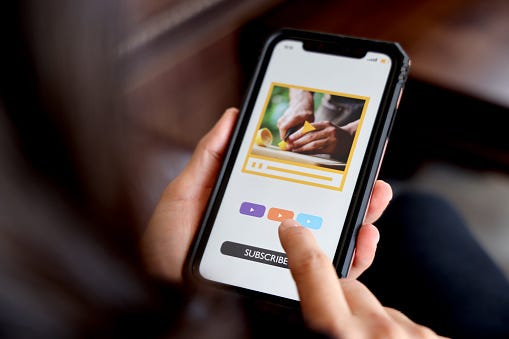One of the greatest misbeliefs the youngest generation holds is believing the grass is greener on the other side.
This mentality is only getting worse due to the plethora of subscriptions out there.
From pet supplies to groceries, you name it, there’s a subscription for it! Surprisingly, they may actually make your life more difficult especially the more you sign up for!
If you find you’re oftentimes convinced everyone around you must have it better simply based on the materialistic items they flaunt, you’ll never be satisfied and are deceiving yourself.
There’s no doubt a shiny new item can certainly make you happy for some time, usually right after purchasing it, but soon after, the attraction, appeal, and reliance on it quickly fades and before you know it, the Joneses across the street already purchased another brand new vehicle and now you are caught up in an endless FOMO cycle! You can never keep up!
Past a certain income adjusted for inflation which stands at around $90k nowadays in the states, your happiness levels start to plateau and at this point, you need to cultivate that internal bliss yourself, or else no matter what you acquire, it won’t raise that baseline bliss for long. Most likely at this stage, unless you’re living in a high-income city with 2+ kids reliant on one salary and investments, your needs are likely met, you have a roof over your head, warm food, hopefully, paid down the house, have people around you that love you, and you can say you’re genuinely satisfied about life. Challenges are inevitable, it’s how you perceive them that matters. Past this point, the majority of happiness you feel is internally cultivated and must be worked on yourself. No external item or subscription will bump up for long.
As with almost everything in life, what you put in is what you get out. There are usually no exceptions, except for in the market when the equity risk premium taken doesn’t add up proportionately and risk-assets such as treasuries, CDs, and HY savings end up yielding you more with less risk taken and the second is when signing up for more subscription services! More items purchased don’t equate to greater value generated especially when you’re adding additional hassle to your monthly expenses.
When it comes to subscriptions, Americans have a problem that’s only getting worse thanks to the use of technology, laziness, and screen time. The average US household is spending close to $220 per month with an average of 9–12 subscriptions across media, entertainment, sports, consumer goods, etc. I’ll say, it’s not completely our fault when there are 5+ streaming competitors out there all showcasing enticing content and in order to watch each one, 5 separate accounts need to be made but it is our choice and needs to stop before it gets worse!
Instead of falling into the trap of signing up for everything to eliminate all possible FOMO and stay up to date with the trends, just like with any budget, you must remember that moderation is key. Setting limits for yourself is necessary to not go overboard or be enticed every time something new comes around because let’s face it, something new will always come around!
It’s called the art of running a business and staying profitable with decent margins! Everything new will look shiny, bigger, and better because you haven’t tried it but don’t fall into this trap this time around. There’s too much out there and controlling yourself must be top of mind.

How To Halt the Breaks On Subscriptions & Know What You Really Need Again
I clearly have a love-hate relationship with subscriptions. They are useful in order to cut down on the cost of shipping, deliveries, and extra handling fees for staple goods however, for the most part, the majority of subscription holders/spenders don’t end up benefiting from the perks their plans promise. They make us lazy and greedy. Even worse, many Americans end up paying for something they never use or forgot about since they signed up for too many in the first place! This is particularly the case in urban areas where subscriptions are literally found on every corner!
The fact that one must keep track of monthly recurring automatic payments steers me away from wanting to sign up for them in the first place! After all, the ‘small’ payments that you don’t think make a big difference creep up on your bills the most! Think about that $6 latte or Uber ride every once in a while. It still gets recorded. Everything adds up over time at the end of the day. Choose how to treat yourself wisely since not everything that’s relatively lower in cost compared to your other monthly expenses is truly worth it.
During the last few days of 2022 while I was reassessing what to cut back on without derailing my lifestyle, I decided the easiest, least painful payments to give up were these pesky subscriptions, mainly found in the form of entertainment and consumer staples/discretionary such as food and grocery.
I was surprised how much I was in control of my saving and spending to put extra cash into the markets and riskless assets with guaranteed returns! My future self would be proud.
I asked myself a few questions to confirm certain subscriptions I could cut were of low value to me going into 2023 to not feel regretful. Although some were tough to cut back on, especially when canceling can take hours on end, I knew there would be no trouble signing back on! It’s sadly always the easiest option that gets consumers in trouble.
-Does this subscription really make my life easier? List at least 4 ways.
-When do I really use this? (track days per week)
-How much time/effort do I save per week by using this service?
-Is there a healthier more realistic option?
-How did I feel/do before I started using this subscription?
-Is the old way really harder/less convenient?
Now, everyone has different values and priorities but since I know myself pretty well, I would be better off trying something different such as reading an entertaining book instead of scrolling for 30 minutes to find a show I don’t end up enjoying. Conducting a cost-benefit analysis based on my time and energy (ROE) of signing up and actually using the platforms and services has been extremely beneficial to choose healthier more realistic options.
I’ve already cut back on 5 subscriptions over the past few months by assessing where I can best spend my time since I’ve found more creative alternatives that suit me better and got more fit just in time for January! If you think outside of the box and don’t just default to what advertisers urge you to cling to, you’ll discover what you really need which is less than you think!
Dig into your WHY. You’ll be surprised by the silly lame reasons you sold yourself on to get that subscription in the first place. The worst case is that you sign up again but chances are, once you have a valid reason to cancel your account, you’ll find a more simplified cost-effective solution to adopt. As species, we don’t prefer change but can change if need be.

Subscription Tags
Over the past few years, I’ve noticed certain people rely on subscriptions more heavily than others based on their location, occupation, popular trends, and even mood at the time. College students and working professionals are more likely to have more similar subscription plans/accounts than parents of small children or HS students based on their temporary needs.
When it comes to investing to making any size purchase, it’s vital to block out the FOMO, emotions, and not make permanent decisions based on temporary emotions. Oftentimes, I’ve found the subscriptions I once thought I needed, I only signed up for because everyone else at the time had it, or even worse, I expected I would need it just in case! The only thing you need just in case is that emergency fund!
In a sense, I kept up with the Joneses and thought my life would be easier because of it but in actuality, keeping track of another expense, waiting for customer service to negotiate, and spending 30+mins finding something to watch or buy wasn’t worth the effort.
Particularly in the city, subscription fatigue and impulse buying are things all city dwellers need to watch out for since there are just more options at our disposal and I find as someone who wants to get as much done as I can and be an efficient queen in the Big Apple, subscriptions tend to be the default since that’s what they sell after all!
Many New Yorkers I’ve spoken to fall into this trap of signing up for things because they see ads plastered all over billboards in the city or see their neighbors get them delivered. With more people using a service, it’s natural to want to check it out until it becomes a pain and more of a hassle to unsubscribe, cancel, and mentally keep track of it all. Might as well be your own accountant and full-time monthly expense assistant.
What’s out of sight is out of mind folks! You’re better off sticking to what works and not upgrading unless of course, it’s a true upgrade to improve your lifestyle, not a fake one.
Less is more in the new year! Embrace it and focus on what you really need to make your life easier in the simplest way possible. Although inflation peaked in October ’22, that doesn’t mean you can let subscriptions slide.
Explore nature, buy those groceries yourself, take that walk, and stick to what works with a limited number of subscriptions this time for good.

